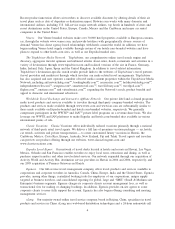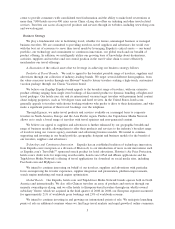Expedia 2008 Annual Report Download - page 20
Download and view the complete annual report
Please find page 20 of the 2008 Expedia annual report below. You can navigate through the pages in the report by either clicking on the pages listed below, or by using the keyword search tool below to find specific information within the annual report.We are in the process of restructuring our global workforce to simplify and streamline our organization,
improve our cost structure and strengthen our overall businesses. These changes could affect employee morale
and productivity and be disruptive to our business.
Our stock price is highly volatile.
The market price of our common stock is highly volatile and could continue to be subject to wide
fluctuations in response to factors such as the following, some of which are beyond our control:
• Quarterly variations in our operating results;
• Operating results that vary from the expectations of securities analysts and investors;
• Changes in expectations as to our future financial performance, including financial estimates by
securities analysts and investors;
• Rating agency credit rating actions;
• Reaction to our earnings releases and conference calls, or presentations by executives at investor and
industry conferences;
• Changes in our capital structure;
• Changes in market valuations of other internet or online service companies;
• Announcements of technological innovations or new services by us or our competitors;
• Announcements by us or our competitors of significant contracts, acquisitions, strategic partnerships,
joint ventures or capital commitments;
• Loss of a major supplier participant, such as an airline or hotel chain;
• Changes in the status of our intellectual property rights;
• Lack of success in the expansion of our business model geographically;
• Announcements by third parties of significant claims or proceedings against us or adverse developments
in pending proceedings;
• Additions or departures of key personnel;
• Rumors or public speculation about any of the above factors; and
• Market and volume fluctuations in the stock markets in general.
Volatility in our stock price could also make us less attractive to certain investors, and/or invite
speculative trading in our common stock or debt instruments.
Our international operations involve additional risks and our exposure to these risks will increase
as we expand our international operations.
We operate in a number of jurisdictions outside of the United States and intend to continue to expand our
international presence. To achieve widespread acceptance in the countries and markets we enter, we must
continue to tailor our services and business model to the unique circumstances of such countries and markets,
including supplier relationships and traveler preferences. Learning the customs and cultures of various
countries, particularly with respect to travel patterns and practices, can be difficult, costly and divert
management and personnel resources. Our failure to adapt our practices and models effectively to the traveler
and supplier preferences of each country into which we expand could slow our international growth.
We expect to continue to face additional risks in international operations. These risks include political
instability; threatened or actual acts of terrorism; changes in regulatory requirements; our ability to comply
with additional U.S. laws applicable to U.S. companies operating internationally as well as local laws and
regulations; diminished ability to legally enforce our contractual rights; increased risk and limits on our ability
to enforce intellectual property rights; possible preferences by local populations for local providers; restrictions
14
























